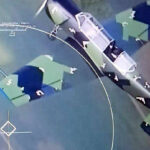Israel has officially declared its Iron Beam laser air defense system operational—a milestone in the global deployment of directed-energy weapons (DEWs). Designed to intercept drones, rockets, and mortars at short ranges using a high-energy laser (HEL), Iron Beam complements Israel’s layered air defense architecture by offering a cost-effective and near-instantaneous response to low-tier aerial threats.
Iron Beam Overview: A Directed Energy Layer in Israel’s Air Defense
Developed by Rafael Advanced Defense Systems in cooperation with the Israeli Ministry of Defense’s Directorate of Defense Research and Development (DDR&D), Iron Beam is a high-energy laser system intended to neutralize short-range threats such as UAVs, rockets, artillery shells (C-RAM), and mortars. The system uses a solid-state fiber laser with an output reportedly exceeding 100 kW—placing it among the most powerful operational HEL systems globally.
Iron Beam is designed as an upper-tier SHORAD (Short-Range Air Defense) asset that operates within Israel’s multi-layered missile defense architecture alongside kinetic systems like Iron Dome (Tamir interceptors), David’s Sling (Stunner missiles), and Arrow. Unlike these systems that rely on expensive interceptors costing tens of thousands to millions per shot, Iron Beam’s cost-per-shot is estimated at just a few dollars—primarily electricity.
Operational Status Confirmed Amid Rising Threats
On September 10, 2025, Israeli defense officials confirmed that Iron Beam had entered operational service following extensive field testing. This announcement follows years of development and accelerated testing prompted by increasing threats from Hezbollah in Lebanon and Hamas in Gaza—both known for deploying swarms of low-cost drones and saturation rocket attacks.
The system reportedly completed successful live-fire trials earlier this year under realistic combat scenarios. According to statements from Rafael and Israeli MoD officials during the Eurosatory 2024 exhibition in Paris and subsequent demonstrations in southern Israel, Iron Beam achieved consistent intercepts against small UAVs and Grad-style rockets at ranges up to several kilometers. While exact range figures remain classified due to operational security concerns, open-source estimates suggest engagement distances between 5–7 km depending on atmospheric conditions.
Tactical Role: Complementing Kinetic Systems Like Iron Dome
Iron Beam does not replace kinetic interceptors but augments them. Its primary advantage lies in its ability to engage targets at near-zero marginal cost with virtually unlimited magazine depth—as long as power is available. This makes it ideal for countering high-volume attacks where interceptor stocks could be rapidly depleted or where economic attrition is unsustainable.
- C-RAM capability: Intercepts incoming mortar rounds or artillery shells before impact.
- Drone neutralization: Targets Class I/II UAVs used for ISR or loitering munitions.
- Saturation resilience: Provides continuous coverage during mass rocket barrages.
- Urban defense: Deployed near civilian areas without risk of interceptor debris fallout.
The system is expected to be deployed alongside mobile batteries of Iron Dome or integrated into fixed installations protecting strategic infrastructure such as airports or power plants. Its silent operation and lack of explosive warheads also make it suitable for urban environments where collateral damage must be minimized.
Technical Challenges and Limitations
Despite its promise, directed energy weapons like Iron Beam face inherent limitations tied to physics. Atmospheric conditions—especially dust storms (common in southern Israel), rain, fog, or smoke—can attenuate beam effectiveness. Additionally:
- Dwell time: The laser must maintain focus on a fast-moving target for several seconds to achieve kill effect through thermal ablation or structural failure.
- Line-of-sight constraint: Targets must be visible within direct line-of-sight; terrain masking can limit coverage arcs.
- Power demand: Sustained operation requires robust electrical infrastructure or mobile generators capable of delivering hundreds of kilowatts per shot cycle.
- No over-the-horizon capability: Unlike radar-guided interceptors with terminal guidance seekers (e.g., Tamir), lasers cannot curve trajectories around obstacles or engage beyond visual range.
This makes integration with radar cueing systems critical; early detection allows the beam director sufficient time to acquire and track targets before they enter lethal proximity zones. Rafael has not disclosed whether Iron Beam uses electro-optical tracking alone or integrates with existing radar networks such as EL/M-2084 Multi-Mission Radar used by other Israeli air defense components.
A Strategic Leap Toward Future DEW Integration
The deployment of Iron Beam marks one of the first confirmed operational uses of high-energy lasers for tactical air defense globally. While other nations—including the U.S., Germany (with Rheinmetall’s Skyranger HEL), China, Russia, South Korea—are developing similar capabilities at various technology readiness levels (TRLs), few have declared full operational deployment beyond experimental units or limited prototypes.
The Israeli program benefited from sustained R&D funding since its public unveiling around 2014–2016. In recent years it received additional budget injections following escalations along Israel’s northern border and increased drone proliferation from Iranian proxies across the region. Notably:
- The U.S.-Israel cooperative DEW roadmap includes potential co-production agreements under FMF frameworks;
- IWI subsidiary OptiDefense reportedly contributed optics subsystems;
- IDF Ground Forces Command may explore vehicle-mounted variants for maneuver brigades;
If scaled effectively—with mobile variants mounted on trucks or armored vehicles—Iron Beam could offer expeditionary forces a lightweight C-UAS/C-RAM solution without logistic burden associated with missile reloads. However, further testing will be needed under contested EW environments where GPS jamming or decoys may complicate targeting chains.
The Road Ahead: Export Potential and Future Upgrades
The operationalization of Iron Beam positions Israel as a leader in practical DEW deployment—a domain long dominated by theoretical promise but hampered by engineering hurdles. While no foreign sales have yet been announced officially by Rafael as of September 2025, interest from U.S., India, UAE—and possibly European NATO allies—is likely given growing demand for cost-effective counter-drone solutions amid expanding UAS threats worldwide.
- Navy applications: Future variants may be adapted for shipboard use against sea-skimming missiles or drone swarms;
- Aerial integration: Long-term concepts include airborne HEL pods on large UAVs or special mission aircraft;
- Pulsed-laser upgrades: Research continues into pulsed vs continuous wave lasers for improved lethality over distance;
If proven scalable across platforms—and resilient under battlefield conditions—Iron Beam could catalyze broader adoption of DEWs within NATO-aligned forces seeking affordable SHORAD enhancements without relying solely on kinetic interceptors vulnerable to saturation tactics.









